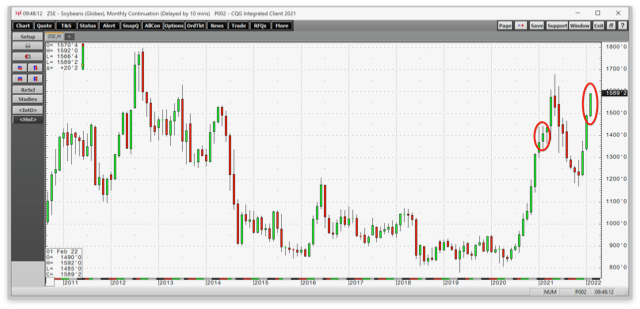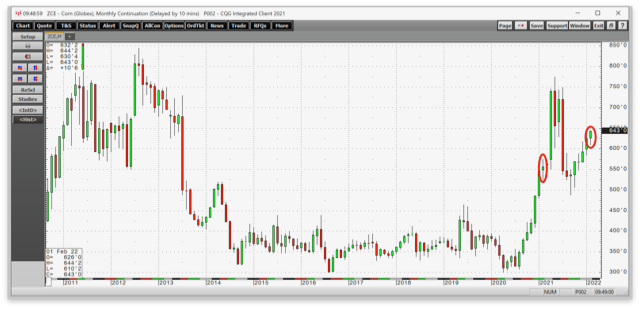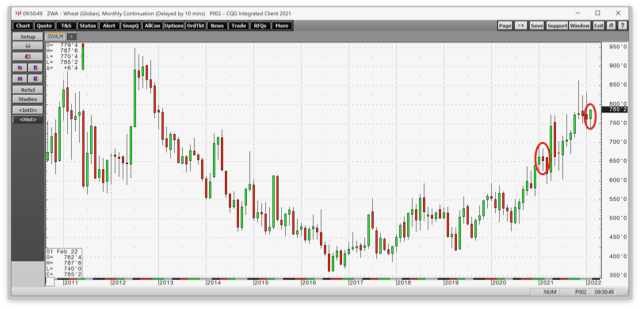This article was written exclusively for Investing.com
- Upward pressure on the agricultural sector
- Beans are in the teens
- Corn is trending higher
- Wheat is sitting near $8 a bushel
- The four factors that could lead to 2022 price explosions
Each year is a new adventure in agricultural commodities as the weather is the primary factor in the path of least resistance for prices. Droughts or floods can cause shortages in the crops that feed the world.
As we head into the 2022 crop year, factors aside from the weather underpin prices, which could cause wild volatility over the coming months. In 2021, corn, soybean and wheat prices rose to the highest levels since 2012.
Inflation at the highest level in four decades has increased farmers’ production costs. Higher fertilizer, energy, equipment, transportation, labor expenses and rising land values mean farmers must receive higher crop prices to keep pace with inflation.
Meanwhile, the global population grows by approximately 20 million each quarter, and the demand for food will be higher in 2022 than in 2021. Moreover, the shift in US energy policy away from fossil fuels in favor of alternative and renewable sources increases corn-based ethanol and soybean-based biodiesel requirements.
While the US is the world’s leading producer and exporter of corn and beans, Russia is the top wheat exporter. Tensions between the US and Russia over Ukraine could cause shortages in wheat supplies in 2022. Fasten your seatbelts for a very volatile year for agricultural products that provide nutrition and energy.
Upward Pressure On The Agricultural Sector
In 2021, inflation became the primary factor impacting the US economy, as the consumer and producer price indices rose to the highest levels in four decades. The central bank blamed increasing inflationary pressures on pandemic-related supply-chain bottlenecks throughout the year, calling them “transitory.” The Federal Reserve did not cite the unprecedented liquidity and government stimulus as a root cause of the economic condition.
In late 2021, the data told the Fed economists that inflation was more structural than temporary, and the central bank now plans to tighten credit. Meanwhile, agricultural producers had already been feeling inflation’s input as energy, farm equipment, fertilizers, land values and all other input prices were moving steadily higher throughout the second half of 2020 and all of 2021. Moreover, labor shortages have lifted wages for farm workers.
When all the input expenses rise, the output prices need to keep pace, or production becomes uneconomic. Over the past year, the leading crop prices have moved steadily higher and are heading into the 2022 crop year in the US and northern hemisphere appreciably higher than the highs in February 2021.
Beans Are In The Teens
On Wednesday, Feb. 9, nearby CBOT soybean futures traded to a high of $15.92 per bushel.

Source: CQG
The monthly chart shows that the Feb. 9 high was 10.3% above the February 2021 peak of $14.43 per bushel. Beans are in the teens before the first seeds go into the ground for the 2022 crop year, and the 2021 high of $16.7725 is a target that is coming closer each day. The all-time high in CBOT soybean futures was in 2012 at $17.9475 per bushel.
Corn Trending Higher
Nearby March CBOT corn futures traded to a high of $6.4425 per bushel on Feb. 9.

Source: CQG
In February 2021, nearby corn future’s was at a high of $5.7425 per bushel, 10.9% below the Feb. 9 high. In 2021, nearby corn futures reached $7.75 per bushel, while in 2012, the all-time high was $8.4375.
Wheat Sitting Near $8 Per Bushel
March CBOT wheat futures at a high of $7.8775 on Feb. 9 was below the recent high at more than $8.30 per bushel.

Source: CQG
The monthly chart shows the high in February 2021 of $6.8350 per bushel, 13.2% below the high price on Feb. 9 for soft red winter wheat futures for March delivery.
The three leading agricultural grain and oilseed futures prices are heading into the 2022 crop year at substantially higher prices than at this time in 2021. Last year, prices moved to multi-year highs.
Four Factors That Could Lead To 2022 Price Explosions
The current price levels in the soybean, corn and wheat futures arena tell us that 2022 could be an even more bullish year than 2021. Four factors, aside from inflation, point to even higher highs over the coming months:
- The season begins with the uncertainty over the weather conditions that will determine the annual crops. Drought or floods could curtail supplies, leading to shortages and price explosions.
- The demand for agricultural commodities that feed the world is rising with the global population that increases at a rate of approximately 20 million people each quarter. In 2022, there are 80 million more mouths to feed than in 2021 as the demand side of the agricultural commodities fundamental equations grow.
- Corn and soybeans are critical ingredients in US ethanol and biodiesel production. As the US and the world address climate change, the coarse grain and oilseeds provide both food and energy to consumers. Rising crude oil and gasoline prices, approaching the highest levels since 2014, put additional upside pressure on corn and soybean prices.
- Russia is the world’s leading wheat exporter. Tensions surrounding Ukraine and the potential for hostilities could create global wheat shortages. Moreover, since wheat is the primary ingredient in bread, the Russians could use blockades or embargos as a tool that would cause wheat prices to soar.
Inflationary pressures continue to push agricultural commodity prices higher. Seasonality and the weather, rising demand for food, new dynamics for energy and geopolitical tensions could cause explosive moves in the price of the commodities that feed and power the world in 2022.
